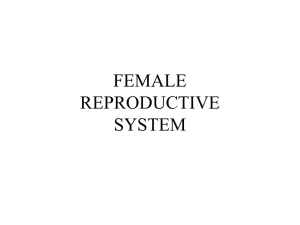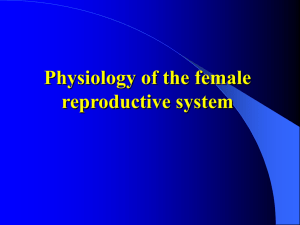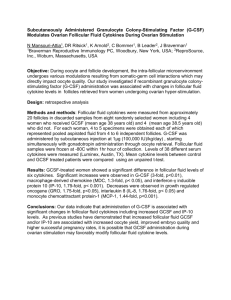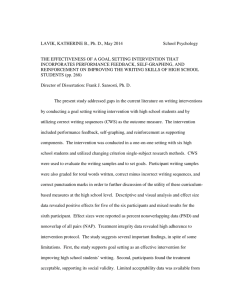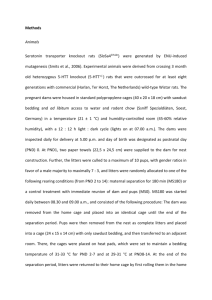Effects of Neonatal Stress on Ovarian Follicular Reserve and Initial Follicular Waves in Rats
advertisement
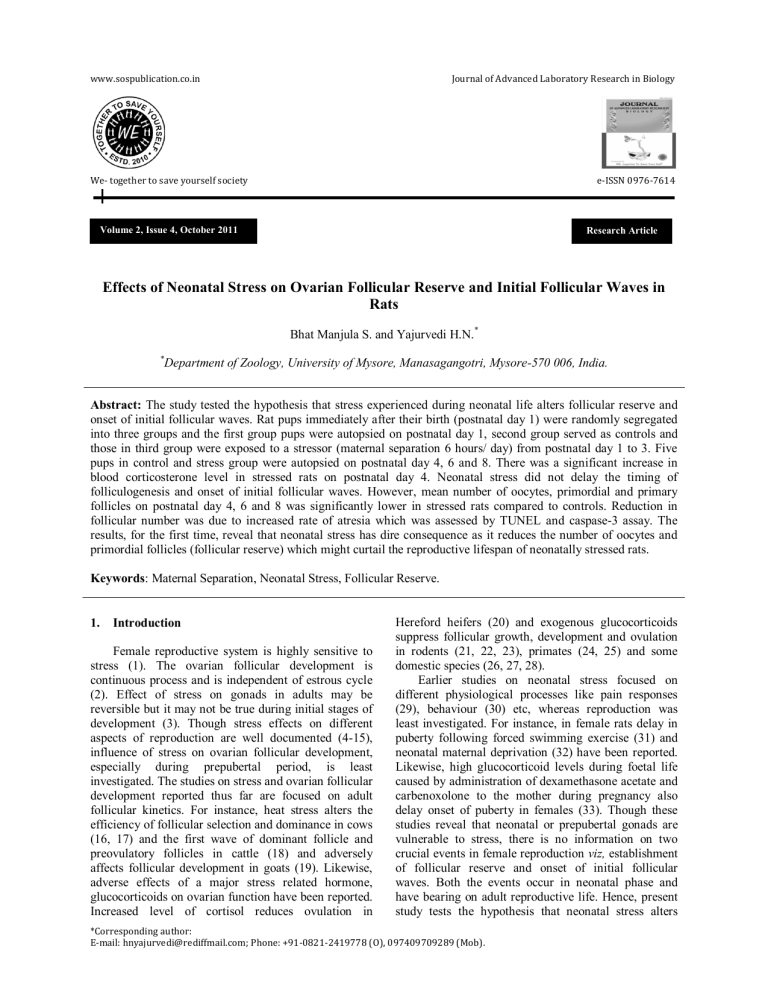
www.sospublication.co.in Journal of Advanced Laboratory Research in Biology We- together to save yourself society e-ISSN 0976-7614 Volume 2, Issue 4, October 2011 Research Article Effects of Neonatal Stress on Ovarian Follicular Reserve and Initial Follicular Waves in Rats Bhat Manjula S. and Yajurvedi H.N.* * Department of Zoology, University of Mysore, Manasagangotri, Mysore-570 006, India. Abstract: The study tested the hypothesis that stress experienced during neonatal life alters follicular reserve and onset of initial follicular waves. Rat pups immediately after their birth (postnatal day 1) were randomly segregated into three groups and the first group pups were autopsied on postnatal day 1, second group served as controls and those in third group were exposed to a stressor (maternal separation 6 hours/ day) from postnatal day 1 to 3. Five pups in control and stress group were autopsied on postnatal day 4, 6 and 8. There was a significant increase in blood corticosterone level in stressed rats on postnatal day 4. Neonatal stress did not delay the timing of folliculogenesis and onset of initial follicular waves. However, mean number of oocytes, primordial and primary follicles on postnatal day 4, 6 and 8 was significantly lower in stressed rats compared to controls. Reduction in follicular number was due to increased rate of atresia which was assessed by TUNEL and caspase-3 assay. The results, for the first time, reveal that neonatal stress has dire consequence as it reduces the number of oocytes and primordial follicles (follicular reserve) which might curtail the reproductive lifespan of neonatally stressed rats. Keywords: Maternal Separation, Neonatal Stress, Follicular Reserve. 1. Introduction Female reproductive system is highly sensitive to stress (1). The ovarian follicular development is continuous process and is independent of estrous cycle (2). Effect of stress on gonads in adults may be reversible but it may not be true during initial stages of development (3). Though stress effects on different aspects of reproduction are well documented (4-15), influence of stress on ovarian follicular development, especially during prepubertal period, is least investigated. The studies on stress and ovarian follicular development reported thus far are focused on adult follicular kinetics. For instance, heat stress alters the efficiency of follicular selection and dominance in cows (16, 17) and the first wave of dominant follicle and preovulatory follicles in cattle (18) and adversely affects follicular development in goats (19). Likewise, adverse effects of a major stress related hormone, glucocorticoids on ovarian function have been reported. Increased level of cortisol reduces ovulation in Hereford heifers (20) and exogenous glucocorticoids suppress follicular growth, development and ovulation in rodents (21, 22, 23), primates (24, 25) and some domestic species (26, 27, 28). Earlier studies on neonatal stress focused on different physiological processes like pain responses (29), behaviour (30) etc, whereas reproduction was least investigated. For instance, in female rats delay in puberty following forced swimming exercise (31) and neonatal maternal deprivation (32) have been reported. Likewise, high glucocorticoid levels during foetal life caused by administration of dexamethasone acetate and carbenoxolone to the mother during pregnancy also delay onset of puberty in females (33). Though these studies reveal that neonatal or prepubertal gonads are vulnerable to stress, there is no information on two crucial events in female reproduction viz, establishment of follicular reserve and onset of initial follicular waves. Both the events occur in neonatal phase and have bearing on adult reproductive life. Hence, present study tests the hypothesis that neonatal stress alters *Corresponding author: E-mail: hnyajurvedi@rediffmail.com; Phone: +91-0821-2419778 (O), 097409709289 (Mob). Neonatal Stress and Onset of Initial Follicular Waves follicular reserve and timing of onset of initial follicular waves in rats. 2. Materials and Methods 2.1 Animals and their maintenance Wistar albino rats bred and maintained by the central animal facility of University of Mysore were used. The rats were maintained in polypropylene cages containing a bed of paddy husk and had free access to food and water throughout the day. The food was standard rat chow pallets of which the nutritional contents were according to recommended standard diet for albino rats. The tap water was provided in clean glass bottles. The rats were maintained in 12:12 light and dark photoperiod (lights from 7 am to 7 pm). Animal care, treatment and anaesthesia were according to the guidelines of the committee for purpose of control and supervision of experiments on animals (CPCSEA). All experimental protocols were approved by the Institutional animal ethics committee (IAEC) of University of Mysore. 2.2 Experimental protocols Postnatal day (PND) 1 pup were used. The body weight of each pup was recorded immediately after birth. Five pups were autopsied on day 1 i.e. immediately after birth and considered as initial controls. The remaining pups along with their mothers were randomly segregated into two groups, controls and stress group. The control pups were maintained without disturbance, whereas those in the stress group were exposed to maternal separation, 6 hours/ day from PND 1 to PND 3. The littermates of each mother in this group were separated from the mother and placed in a different cage having appropriate bedding. After 6 hours all the pups were shifted back to cage of their mother. Timing of separation was randomly changed every day to avoid habituation. Five pups from both the groups were autopsied on PND 4, 6 and 8. At autopsy weight of the body and the ovary was recorded, and later converted into relative weight (weight per 100g body weight). The right ovary was fixed in Bouin’s fixative and the left ovary in buffered formaldehyde glutaraldehyde for histological and immunohistochemical studies respectively. The blood sample was collected, serum was separated and stored at -200C until corticosterone concentration was determined. 2.3 Histology and follicle counts The ovaries fixed in Bouin’s fluid were processed according to the standard histological method and 5µm thick serial paraffin sections were cut and stained with hematoxylin and eosin. Different categories of follicles were identified and classified according to Pedersen and Peters (34). Oocytes within the syncytium were J. Adv. Lab. Res. Biol. Bhat and Yajurvedi counted from each section. The naked oocytes were counted from every alternate section, the primordial follicles from every 4th section and primary follicles (type 3a) from every 6th section. A different procedure was followed for 3b type primary follicles (advanced primary follicles). Each section was observed and only the 3b follicle showing full size oocyte was included in counts and care was taken not to count the same follicle more than once. 2.4 TUNEL (Terminal deoxynucleotidyl transferase dUTP nick end labeling) assay The follicular atresia, determined by histological observation i.e. presence of more than 5% pycnoitic granulosa cells, was further characterized by conducting TUNEL and caspase 3 assays. Serial sections (8µm) were cut from the left ovary fixed in buffered formaldehyde-glutaraldehyde and the sections were spread on 3-aminopropyltriethoxysilane coated micro slides. Some sections were randomly selected for conducting TUNEL assay. The assay was performed using the kit supplied by Roche Diagnostics India Pvt. Ltd., Chennai, India following the procedures of the kit manufacturers. The number of TUNEL positive and negative granulosa cells were counted in randomly selected areas in each section and expressed in terms of percentage of TUNEL positive and negative cells. 2.5 Immunohistochemical localization of caspase-3 Some randomly selected sections of the left ovary fixed in buffered formaldehyde-glutaraldehyde were spread on 3-aminopropyltriethoxysilane coated slides. The primary antibody (anti-mouse caspase-3) was purchased from Bi Biotech India Pvt. Ltd., R&D Systems, New Delhi, India and a standard immunohistochemistry technique protocol (35) was used. Caspase-3 positive and negative cells were counted from randomly selected areas and percentage of positive and negative cells was calculated. 2.6 Estimation of serum concentration of corticosterone The corticosterone concentration was determined by enzyme linked immunosorbent assay (ELISA) using the kit purchased from Neogen Corporation, Canada. The corticosterone was extracted from the serum collected and stored at -200C at autopsy, following the procedure of the kit manufacturer. 2.7 Statistical analysis The mean values of each parameter were computed using data on a minimum of five animals in each group and expressed as mean ± SE. The mean values were compared by one way analysis of variance followed by Duncan’s multiple range test and judged significant if p<0.05. All statistical analyses were carried out using SPSS 17. 147 Neonatal Stress and Onset of Initial Follicular Waves 3. Bhat and Yajurvedi PND 4 and 6 and that of caspase-3 on PND 8 was significantly higher compared to controls (Table- 3). Results 3.1 Body and ovary weight The body weight of pups in both the groups showed a significant increase over initial controls at all the ages studied. There was a significant decrease in the body weight and percent gain in body weight of stress group rats on PND 4, 6 and 8 compared to controls (Table-1). Relative weight of the ovary was significantly lower in stressed rats on PND 4, 6 and 8 compared to controls (Table-1). 3.2 Histology of the ovary and follicular counts On PND 1 (initial controls) follicles of any category were absent and the ovary contained only oocytes either within the syncytium or as naked oocytes. On PND 4 ovaries of both the control and stressed rats contained naked oocytes (type 1) and primordial follicles (type 2) (Fig. 1. a & b). The primary follicles (3a) and advanced primary follicles (3b) were present in the ovaries of both control and stressed rats on PND 6 and PND 8 respectively in addition to oocytes and primordial follicles. Mean number of oocytes was significantly lower in stress group on PND 4 and 6 whereas it did not significantly vary on PND 8 compared to controls (Table-2). Mean number of primordial follicles was significantly lower in stressed rats on PND 6 and 8 compared to controls (Table-2). Similarly, mean number of primary follicles (type 3a) was significantly lower in stressed rats compared to controls on PND 6 and 8 (Table-2). Mean number of advanced primary follicle (type 3b) was significantly lower in stressed rats on PND 8 compared to controls (Table-2). 3.3 TUNEL assay and caspase3 localization The ovaries of stressed rats revealed the presence of more number of TUNEL (Fig. 2b) and caspase-3 (Fig. 3b) positive granulosa cells compared to controls. In stressed rat’s percentage of TUNEL positive cells on a b Fig. 1a & 1b. Cross Sections of the ovary showing oocytes (O) and primordial Follicles (PF) on postnatal day 4 in both the control (Fig. 1a) and stressed (Fig. 1b) rats. H & E, 400X. 3.4 Serum Corticosterone levels Mean serum concentration of corticosterone was significantly higher in stressed rats on PND 4 compared to controls (Table-1). Table 1. Effect of Stress Experienced during Neonatal Period on Body and Ovary Weight and Serum Corticosterone Levels in Rat. Groups Initial controls PND 4 Control group Stress group PND 6 Control group Stress group PND 8 Control group Stress group ANOVA F value Mean body weight (g) a 3.88±0.03 b 7.70±0.12 c 6.78±0.08 b 8.30±0.12 c 6.70±0.12 d 11.80±0.56 e 9.90±0.10 118.13 (df= 6, 28) (p<0.05) Percentage of increase in body weight compared to initial weight a 56.64±3.45 b 22.17±1.76 a 66.75±5.58 b 33.55±5.13 c 129.95±11.88 d 87.63±5.37 37.20 (df=5,24) (p< 0.05) Relative weight of ovary (mg/ 100g of body weight) a 43.29±0.46 b 52.85±0.48 a 43.14±0.69 b 53.33±0.35 a 44.42±1.64 c 56.80±0.27 a 44.66±0.27 58.95 (df=6,28) (p< 0.05) Serum corticosterone level (ng/ml) a 0.75±0.002 b 1.73±0.002 177.37 (df=1, 4) (p< 0.05) All values are mean ±SE, df, degrees of freedom; PND, postnatal day All values are Mean ±SE; Mean values with same superscript letters in a given column are not significantly different, whereas those with different superscript letters are significantly (P<0.05) different as judged by Duncan’s multiple test. J. Adv. Lab. Res. Biol. 148 Neonatal Stress and Onset of Initial Follicular Waves Bhat and Yajurvedi Table 2. Mean Number of Oocytes, Primordial follicles and Primary follicles (type 3a and 3b) per ovary in Control and Stressed rats. Mean number/ ovary ± SE Follicles Groups Oocytes Initial controls (PND 1) Control group PND 4 Stress group Control group PND 6 Stress group Control group PND 8 Stress group ANOVA F value 21397.2±268.63 b 18476. 6±666.06 c 15107±622.14 d 8061.8±357.89 e 5360±121.65 f 1268.4±52.11 f 965.8±122.45 450.75 (df=6,28) P<0.01 Primordial (type 2) a Nil a 176±21.37 a 59.8±10.56 b 6669.6±353.12 c 5438±122.07 d 3187.6±150.18 e 2227.8±42.65 267.29 (df=5,24) P<0.1 Primary type 3a type 3b Nil Nil Nil Nil Nil Nil a 284.4±22.9 Nil b 100.6±10.9 Nil c a 299±13.9 284.4±22.9 d b 182.4±3.5 100.6±10.9 34.66 45.46 (df=3,16) P<0.1 (df=1,8) P<0.01 All values are mean ±SE, df, degrees of freedom; PND, postnatal day All values are Mean ±SE; Mean values with same superscript letters in a given column are not significantly different, whereas those with different superscript letters are significantly (P<0.05) different as judged by Duncan’s multiple test. Fig. 2a & 2b. Cross Sections of the ovary showing TUNEL Staining in Control (Fig. 2a) and stressed (Fig. 2b) rats on PND 8. Note the presence of More Number of TUNEL Positive Granulosa Cells in stressed rats compared to Controls. 100X. Table 3. Mean Percentage of Granulosa cells showing Positive and Negative staining for TUNEL assay and Caspase-3 immunolocalization in Control and Stressed rats. Percentage of granulosa cells Groups Initial controls (PND 1) Control group PND 4 Stress group Control group PND 6 Stress group Control group PND 8 Stress group F value (df=6, 14) 4. TUNEL assay Negative a 55.00±3.05 b,d 84.00±1.15 c 73.66±1.76 b 82.66±2.96 c 74.00±3.60 d 90.33±0.88 d 83.66±0.88 25.29 (p< 0.05) Positive a 45.00±3.05 b,d 16.00±1.15 c 26.34±1.76 b 17.34±2.96 c 26.00±3.60 d 9.67±0.88 b,d 16.33±0.88 25.29 (p< 0.05) Caspase- 3 Negative Positive a 100.0000 Nil a 100.00±00 Nil a 100.00±00 Nil a,b a,b 98.66±0.88 1.34±0.88 b,c b,c 97.66±0.33 2.34±0.33 c c 96.00±0.57 4.00±0.57 d d 90.33±1.20 9.67±1.20 32.26 (p< 0.05) 32.26 (p< 0.05) All values are mean ±SE, df, degrees of freedom; PND, postnatal day All values are Mean ±SE; Mean values with same superscript letters in a given column are not significantly different, whereas those with different superscript letters are significantly (P<0.05) different as judged by Duncan’s multiple test. Discussion Activation of the hypothalamo-pituitary-adrenal axis leading to excessive secretion of glucocorticoid is a familiar response to stressors in vertebrates (36, 37, 38). Maternal separation is a widely used stressor to study effects of stress in neonatal rats (32, 39, 40). Increased serum corticosterone level was found in young rats due to maternal separation indicating a condition of stress J. Adv. Lab. Res. Biol. (41). In addition, loss of body weight is expected in stressed young animals as stress inhibits feeding behaviour (42). In the present study, maternal separation 6 hours/ day for 3 days i.e. from PND 1 to 3 resulted in an increase in serum level of corticosterone on PND 4 as well as reduction in percentage of body weight gain on PND 4, 6 and 8 indicating maternal separation induced stress in neonatal rats and hence, the ovarian changes were stress responses. 149 Neonatal Stress and Onset of Initial Follicular Waves Bhat and Yajurvedi Fig. 3a & 3b. Cross sections of the ovary showing caspase- 3 Immuno Localization on PND 8 in control (Fig. 3a) and stressed (Fig. 3b) rats. Note the presence of more number of granulosa Cells Showing Caspase-3 Localization in stressed rats compared to controls. 100X. Our observation that the ovary contained only oocytes whereas follicles of any category were absent on postnatal day 1 is in agreement with earlier reports that folliculogenesis occurs after birth in rats (43, 44). It is known that primordial follicles are formed by postnatal day 3 and immediately after their differentiation a subset of follicles begins to grow and constitute the initial follicular waves, leading to the formation of primary follicles (45, 46, 47). In our present study, timing of formation of primordial and primary follicles in controls was similar to earlier reports as on PND 1, only oocytes were present, and primordial and primary follicles were found on PND 4 onwards. Since the establishment of follicular reserve (i.e. primordial follicles) and onset of initial follicular waves i.e. subset of primordial follicles entering into growth phase, leading to formation of primary follicles occur in first 3 days life of rat, this period (PND 1 to 3) was selected to study stress effects on these two crucial events. Indeed the results show severe effect of stress on neonatal ovarian activity. Exposure of pups to maternal separation in first 3 days of life in the present study did not alter timing of formation of follicular reserve and onset of initial follicular waves as oocytes on PND 1 and primordial and primary follicles on PND 4 were found in stressed as well as in control pups and chronology of events was comparable to earlier studies (45-48). However, there were drastic quantitative changes. There was loss of oocytes, primordial follicles and primary follicles in stressed rats in the range of 20-50% at different age intervals studied compared to controls. The most significant observation was about 30% loss of primordial follicles, which form the follicular reserve (the stockpile of follicles) and are the source of higher category follicles throughout the reproductive lifespan. Present study is the first report, revealing stress induced reduction in size of follicular reserve in mammals. This effect may curtail the reproductive lifespan of female rats, a majority of workers opine that the primordial follicles are formed in prenatal or postnatal ovaries and their number is finite and not renewable in mammals J. Adv. Lab. Res. Biol. (34, 49 - 55). The fact that experimental deletion of follicular reserve in rats did not result in renewal of lost follicles and lead to early reproductive senescence (46, 47) supports this view. Hence, loss of follicular reserve, due to stress in early life might reduce the reproductive lifespan and thereby reproductive potential of female mammals. Loss of follicles and germ cells by atresia is found in the ovaries at all stages of life and it is an apoptotic process (56). However, certain conditions may enhance the follicular atresia, leading to more loss of follicles than under normal circumstances. Stress induced apoptosis and loss of follicles are found in several earlier studies, for instance, thermal stress resulted in increased rate of apoptosis in cows (57 - 60). Caspases are executioners of apoptosis (61, 62). An important function of caspases is to activate the caspase activated DNase (CAD), the endonuclease responsible for internucleosomal DNA fragmentation which is the hallmark of apoptosis (62). Caspase-3 is the most effective caspase and its activation leads to the final stages of cellular death, by proteolytic dismantling of large variety of cellular components (63, 64) and it is functionally required for granulosa cell apoptosis during follicular atresia (65). The cleavage of genomic DNA during apoptosis may yield double as well as single strand breaks (nicks), which can be identified by labeling 3-1 OH terminal with modified nucleotidyltransferase, which catalyses polymerization of labeled nucleotides to free 3-1 OH DNA ends in template independent manner. In the present study decrease in the mean number of primordial or primary follicles was accompanied by increase in immunoreactivity of caspase-3 as shown by increase in percentage of granulosa cells showing caspase-3 reactions, indicating apoptosis. An increase in percentage of TUNEL positive granulosa cells in stressed rats, indicating DNA strand breaks concomitant with increased caspase activity further supports stress induced follicular atresia. Gross histological observations also revealed more number of atretic follicles in stressed rats. The present study 150 Neonatal Stress and Onset of Initial Follicular Waves presents a clear evidence that neonatal stress causes reduction in follicular reserve in rats by apoptosis which might result in early reproductive senescence and reduced reproductive potential. Bhat and Yajurvedi [12]. Acknowledgment [13]. The work has supported a grant (F.32519/2006(SR) by University Grants Commission, India. References [1]. Warren, M.P. & Perlroth, N.E. (2001). The effect of intense exercise on the female reproductive system. Journal of Endocrinology, 170, 3-11. [2]. Singh, D., Sharma, M.K. & Pandey, R.S. (1999). Biochemical and hormonal characterization of follicles from follicular and luteal phase ovaries of goat. Indian Journal of Experimental Biology, 37: 434-438. [3]. Armstrong, D.T. (1986). Environmental stress and ovarian function. Biology of Reproduction, 34: 29-39. [4]. D’Agostino, J., Valadka, R.J. & Schwartz, N.B. (1990). Differential effects of in vitro glucocorticoids on leutinizing hormone and follicle-stimulating hormone. Endocrinology, 127: 891-899. [5]. Brann, D.W., Putnam, C.D. & Mahesh, V.B. (1990). Corticosteroid regulation of gonadotropin and prolactin secretion in the rat. Endocrinology, 126: 159-166. [6]. Brann, D.W., Putnam, C.D. & Mahesh, V.B. (1990). Corticosteroids regulation of gonadotropin secretion and induction of ovulation in rat. Proc. Soc. Exp. Biol. Med., 193: 176-180. [7]. Brann, D.W., Putnam, C.D. & Mahesh, V.B. (1991). Validations of the mechanisms proposed for the stimulatory and inhibitory effects of progesterone on gonadotropin secretion in the estrogen-primed rat: A possible role for adrenal steroids. Steroids, 56: 103-111. [8]. Khan, K.S., Chien, P.F. & Khan, N.B. (1998). Nutritional stress of reproduction. A cohort study over two consecutive pregnancies. Acta. Obstet. Gynecol. Scand., 77: 395-401. [9]. Al-Katanani, Y.M., Paula-Lopes, F.F. & Hansen, P.J. (2002). Effect of season and to exposure heat stress on oocyte competence in Holstein cows. J. Dairy. Sci., 85: 390-396. [10]. Dobson, H., Ghuman, S., Prabhakar, S. & Smith, R. (2003). A conceptual model of the influence of stress on female reproduction. Reproduction, 125: 151-163. [11]. Kongsted, A. (2004). Stress and fear as possible mediators of reproduction problems in group housed sows: A review. Acta Agriculturae J. Adv. Lab. Res. Biol. [14]. [15]. [16]. [17]. [18]. [19]. [20]. [21]. [22]. [23]. [24]. Scandinavica, Section A — Animal Science, 54: 58-66. Agarwal, A., Gupta, S. & Sharma, R.K. (2005). Role of oxidative stress in female reproduction. Reproductive Biology and Endocrinology, 3(28): 1-21. Nepomnaschy, P.A., Sheiner, E., Mastorakos, G. & Arck, P.C. (2007). Stress, immune function, and women’s reproduction. Ann. N. Y. Acad. Sci., 1113: 350-364. Borell, E.V., Dobson, H. & Prunier, A. (2007). Stress, behavior, reproductive performance in female cattle and pigs. Hormones and Behavior, 52: 130-138. Bolocan, E. (2009). Effect of heat stress on sexual behavior in Heifers. Zootehnie si Biotehnologii, 42(1): 141-148. Badinga, L., Thatcher, W.W., Diaz, T., Drost, M. & Wolfenson, D. (1993). Effect of environmental heat stress on follicular development and steroidogenesis in lactating Holstein cows. Theriogenology, 39: 797–810. Jordan, E.A. (2003) Effects of Heat Stress on Reproduction. J. Dairy Sci., 86: E104-E114. Wolfenson, D., Thatcher, W.W., Badinga, L. Savio, J.D., Meidan, R., Lew, B.J., Braw-Tal, R., Berman, A. (1995). The effect of heat stress on follicular development during estrous cycle in lactating dairy cattle. Biol. Reprod., 52: 11061113. Ozawa, M., Tabayashi, D. Latief, T.A., Shimizu, T., Oshima, I. & Kanai, Y. (2005). Alterations in follicular dynamics and steroidogenic abilities induced by heat stress during follicular recruitment in goats. Reproduction, 129: 621–630. Edwards, L.M., Rahe, C.M., Graffin, J.L., Wolfe, D.F., Marpel, D.N., Cummis, K. & Pitchett, J.F. (1987). Effect of transportation stress on ovarian function is superovulated Hereford heifers. Theriogenology, 28: 291-299. Smith, E.R., Johnson, J., Weick, R.F., Levine, S. & Davidson, J.M. (1971). Inhibition of the reproductive system in immature rats by intracerebral implantation of cortisol. Neuroendocrinology, 8: 94-106. Baldwin, D.M. & Sawyer, C.H. (1974). Effects of dexamethasone on LH release and ovulation in the cyclic rat. Endocrinology, 94: 1397-1403. Baldwin, D.M. (1979). The effect of glucocorticoids on estrogen-dependent luteinizing hormone release in the ovariectomized rat and on gonadotropin secretin in the intact female rat. Endocrinology, 105: 120-128. Cunningham, G.R., Goldzieher, J.W., de la Pena, A. & Oliver, M. (1978). The mechanism of ovulation inhibition by triamcinolone acetonide. Journal of Clinical Endocrinology and Metabolism, 46: 8-14. 151 Neonatal Stress and Onset of Initial Follicular Waves [25]. Hayashi, K.T, & Moberg, G.P. (1990). Influence of the hypothalamic-pituitary-adrenal axis on the menstrual cycle and the pituitary responsiveness to estradiol in the female rhesus monkey (Macaca mulatta). Biology of Reproduction, 42: 260-265. [26]. Barb, C.R., Kraeling, R.R., Rampacek, G.B., Fonda, E.S. & Kiser, T.E. (1982). Inhibition of ovulation and LH secretion in the gilt after treatment with ACTH or hydrocortisone. Journal of Reproduction and Fertility, 64: 85-92. [27]. Stoebel, D.P. & Moberg, G.P. (1982). Effect of adrenocorticotropin and cortisol on luteinizing hormone surge and estrous behavior of cows. Journal of Dairy Science, 65: 1016-1024. [28]. Daley, C.A., Macfarlane, M.S., Sakurai, H. & Adams, T.E. (1999). Effect of stress-like concentrations of cortisol on follicular development and the preovulatory surge of LH in sheep. Journal of Reproduction and Fertility; 117: 11-16. [29]. Coutinho, S.V., Plotsky, P.M., Sablad, M., Miller, J.C., Zhou, H., Bayati, A.I., McRoberts, J.A. & Mayer, E.A. (2002). Neonatal maternal separation alters stress-induced responses to viscerosomatic nociceptive stimuli in rat. Am. J. Physiol. Gastrointest. Liver Physiol., 282: G307-G316. [30]. Hofer, M.A. (1975). Studies on how early maternal separation produces behavioral change in young rats. Psychosomatic Medicine, 37(3): 245-264. [31]. Pellerin –Massicotte, J., Brisson, G.R., St-Pierre, C., Rioux, P. & Rajotte, D. (1987). Effect of exercise on the onset of puberty, gonadotropin and ovarian inhibin. Journal of Applied Physiology, 63: 1165- 1173. [32]. Lau, C., Klinefelter, G. & Cameron, A. (1996). Reproductive development and function in the rat after repeated maternal deprivation stress. Fundamental and Applied Toxicology, 30: 298301. [33]. Smith, J.T. & Waddel, B.J. (2000). Increased fetal glucocorticoid exposure delays puberty onset in postnatal life. Endocrinology, 141: 2422- 2428. [34]. Pedersen, T. & Peters, H. (1968) Proposal for a classification of oocytes and follicles in the mouse ovary. J. Reprod. Fertil., 17: 555-557. [35]. Feranil, J.B., Isobe, N. & Nakao. T. (2005). Apoptosis in the antral follicles of swamp buffalo and cattle ovary: TUNEL and caspase-3 histochemistry. Reprod. Domest. Anim., 40: 111116. [36]. Ferin, M. (1999). Clinical review 105: Stress and the reproductive cycle. J. Clin. Endo and Met., 84 (6): 1768-1774. [37]. Kapoor, A., Dunn, E., Kostaki, A., Murcus, M.H. & Matthews, S.G. (2006). Fetal programming of hypothalamo-pituitary-adrenal function: prenatal J. Adv. Lab. Res. Biol. Bhat and Yajurvedi [38]. [39]. [40]. [41]. [42]. [43]. [44]. [45]. [46]. [47]. [48]. [49]. stress and glucocorticoids. J. Physiol., 572(1): 3144. Romeo, R.D., Bellani, R., Karatsoreos, I.N., Chhua, N., Vernov, M., Conrad, C.D. & McEwen, B.S. (2006). Stress history and pubertal development interact to shape hypothalamicpituitary-adrenal axis plasticity. Endocrinology, 147: 1664-1674. Rhees, R.W., Lephart, E.D. & Eliason, D. (2001). Effect of maternal separation during early postnatal development on male sexual behavior and female reproductive function. Behave. Brain Res., 123(1): 1-10. Kwak, H.R., Lee, J.W., Kwon, K.J., Kang, C.D., Cheong, Y., Chun, W., Kim, S. & Lee, H.J. (2009). Maternal social separation of adolescent rat induces hyperactivity and anxiolytic behavior. Korean J. Physiol. Pharmacol., 13: 79-83. Wilber, A.A., Southwood, C.J., Sokoloff, G., Steinmetz, J.E. & Wellman, C.L. (2007). Neonatal maternal separation alters adult eyeblink conditioning and glucocorticoid receptor expression in the interpositus nucleus of the cerebellum. Dev. Neurobiol., 67: 1751–1764. Carr, J.A. & Norris, D.O. (2005). The adrenal gland. In: Endocrine disruption. Biological basis for health effects in wildlife and humans. (Eds: Norris, D.O., and Carr, J.A.,) Oxford university press. USA. 111- 134. Peters, H. & McNutty, K.P. (1980). The ovary. Granada Publishing Ltd., London Toronto Sydney, New York. Greenwald, G.S. & Roy, S.K. (1994). Follicular development and its control. In the physiology of reproduction. Eds. Knobil, E., and J. D. Neil, Ravan Press, New York, 629- 724. McGee, E.A. & Hsueh, A.J. (2000). Initial and cyclic recruitment of ovarian follicles. Endocrine Reviews, 21(2): 200-214. Guigon, C.J., Mazaud, S., Forest, M.G., BraillyTabard, S., Coudouel, N. & Marge, S. (2003a). Unaltered development of the initial follicular waves and normal pubertal onset in female rats after neonatal deletion of the follicular reserve. Endocrinology, 144(8): 3651-3662. Guigon, C.J., Mazaud, S., Forest, M.G., BraillyTabard, S. & Marge, S. (2003b). Role of first wave of growing follicles in rat ovarian maturation. Ann. Endocrinol. (Paris), 64: 85. Mazaud, S., Guigon, C.J., Lozach, A., Coudouel, N., Forest, M.G., Goffigerney, H. & Marge, S. (2002). Establishment of reproductive function and transient fertility of female rats lacking primordial follicle stack after fetal ɤ- irradiation. Endocrinology, 143: 4775- 4787. Zuckerman, S. (1951). The number of oocytes in the mature ovary. Recent Prog. Horm. Res., 6: 63–108. 152 Neonatal Stress and Onset of Initial Follicular Waves [50]. Borum, K. (1961). Oogenesis in the mouse. A study of meiotic prophase. Exp. Cell Res., 24: 495–507. [51]. Peters, H. (1970). Migration of gonocytes into the mammalian gonad and their differentiation. Philos. Trans. R. Soc. Lond. B. Biol. Sci., 259: 91–101. [52]. McLaren, A. (1984). Meiosis and differentiation of mouse germ cells. Symp. Soc. Exp. Biol., 38: 7– 23. [53]. Anderson, L.D. & Hirshfield, A.N. (1992). An overview of follicular development in the ovary: from embryo to the fertilized ovum in vitro. Md. Med. J., 41: 614–620. [54]. Brisol-Gould, S.K., Kreeger, P.K., Selkirk, C.G., Kilen, S.M., Mayo, K.E., Shea, L.D. & Woddruff, T.K. (2006). Fate of the initial follicle pool: empirical and mathematical evidence supporting its sufficiency for adult fertility. Developmental Biology, 298: 149-154. [55]. Eggan, K., Jurga, S., Gosden, R., Min, I.M. & Wagers, A.J. (2006). Ovulated oocytes in adult mice derived from non-circulating germ cells. Nature, 441: 1109-1114. [56]. Durlinger, A.L.L., Kramer, P., Karels, B., Grootegoed, J.A., Uilenbroek, J.T.J. & Themmen, A.P.N. (2000). Apoptotic and proliferatic changes during induced atresia of pre-ovulatory follicles in the rat. Human Reproduction, 15(12): 2504-2511. [57]. Roth, Z. and Hansen, P.J. (2004a). Involvement of apoptosis in disruption of developmental competence of bovine oocytes by heat shock during maturation. Biol. Reprod., 71: 1898–1906. J. Adv. Lab. Res. Biol. Bhat and Yajurvedi [58]. Roth, Z. and Hansen, P.J. (2004b). Sphingosine 1phosphate protects bovine oocytes from heat shock during maturation. Biol. Reprod., 71: 2072– 2078. [59]. Soto, P. and Smith, L.C. (2009). BH4 peptide derived from Bcl-xL and Bax-inhibitor peptide suppresses apoptotic mitochondrial changes in heat stressed bovine oocytes. Mol. Reprod. Dev., 76: 637–646. [60]. Hansen, P.J. (2009). Effects of heat stress on mammalian reproduction. Phil. Trans. R. Soc. B., 364: 3341-3350. [61]. Hengartner, M.O. (2000). The biochemistry of apoptosis. Nature, 407:770–776. [62]. Markstrom, E., Svensson, E.Ch., Shao, R., Svanberg, B. & Billing, H. (2002). Survival factors regulating ovarian apoptosis- dependence on follicle differentiation. Reproduction, 123: 2330. [63]. Nicholson, D.W. (1999). Caspase structure, proteolytic substrates, and function during apoptotic cell death. Cell Death Differ., 6:1028– 1042. [64]. Yakobi, K., Wojtowicz, A., Tsafriri, A. & Gross, A. (2004). Gonadotropins enhance caspase-3 and -7 activity and apoptosis in the theca-interstitial cells of rat preovulatory follicles in culture. Endocrinology, 145: 1943- 1951. [65]. Matikainen, T., Perez, G.I., Zheng, T.S., Kluzak, T.R., Reuda, B.R., Flavell, R.A. & Tilly, J.L. (2001). Caspase-3 gene knockout defines cell lineage specificity for programmed cell death signaling in the ovary. Endocrinology, 142(6): 2468- 80. 153
